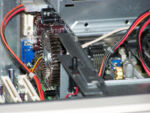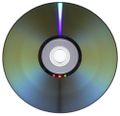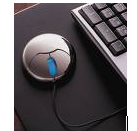3.2 Hardware components
Hardware
The hardware are the parts of a computer. These include the Central Processing Unit (CPU), related microchips and micro-circuitry, keyboards, monitors, case and drives (floppy, hard, CD, DVD, optical, tape, etc...).- Other extra parts called peripheral components or devices include mouse, printers, modems, scanners, digital cameras and cards (sound, colour, video) etc... Together they are often referred to as a personal computers or PCs.
Central Processing Unit (CPU) refers to a specific chip, the processor. Its performance is determined by the the rest of the computers circuitry and chips. Currently the Pentium processor made by Intel is the most common processor. Many other companies, like Motorola and AMD, produce processors for personal computers.
A processor's speed is its most vital attribute. Pentium chips began at 75 MHz in the late 90's. Speeds now exceed 3GHz. It depends on the circuit board that the chip is housed in, or the motherboard, as to whether you are able to upgrade to a faster chip. The motherboard contains the circuitry and connections that allow the various components to communicate with each other.
Some of the keys have a special use. There are referred to as command keys. The 3 most common are the Control or CTRL, Alternate or Alt and the Shift keys though there can be more (the Windows key for example or the Command key). Each key on a standard keyboard has one or two characters. Press the key to get the lower character and hold Shift to get the upper.
Disk Drives - All disks need a drive to help red informatiion from them or write onto them. Drives are designed to correspond to the specific type of disk: CD, DVD, hard disk or floppy. Often the term 'disk' and 'drive' are used to describe the same thing but it helps to understand that the disk is the storage device which contains computer files - or software - and the drive is the mechanism that runs the disk.
One type of mouse has a round ball under the bottom of the mouse that rolls and turns two wheels which control the direction of the pointer on the screen. Another type of mouse uses an optical system to track the movement of the mouse.
Note: It is important to clean the mouse periodically, particularly if it becomes sluggish. A ball type mouse has a small circular panel that can be opened, allowing you to remove the ball. Lint can be removed carefully with a tooth pick or tweezers and the ball can be washed with mild detergent. A build up will accumulate on the small wheels in the mouse. Use a small instrument or finger nail to scrape it off taking care not to scratch the wheels. Track balls can be cleaned much like a mouse and touch-pad can be wiped with a clean, damp cloth. An optical mouse can accumulate material from the surface that it is in contact with which can be removed with a finger nail or small instrument.
Most desktop computers use a monitor with a cathode tube and most notebooks use a liquid crystal display (LCD) monitor. To get the full benefit of today's software with full colour graphics and animation, computers need a color monitor with a display or graphics card.
Dot matrix printers work like a typewriter transferring ink from a ribbon to paper with a series or 'matrix' of tiny pins. Ink jet printers work like dot matrix printers but fires a stream of ink from a cartridge directly onto the paper. Laser printers use the same technology as a photocopier using heat to transfer toner onto paper. Modem - A modem is used to translate information transferred through telephone lines or cable.
The term stands for modulate and demodulate which changes the signal from digital, which computers use, to analog, which telephones use and then back again. A high speed connection also requires a modem but because the information is transferred digitally it isn't required to change the signal from digital to analog but is used to create the connection between your computer and the computer you are connecting with.
Modems are measured by the speed that the information is transferred. The measuring tool is called the baud rate. Originally modems worked at speeds below 2400 baud but today analog speeds of 56,000 are common. Cable, wireless or digital subscriber lines (DSL) modems can transfer information much faster with rates of 300,000 baud and up.
Modems also use Error Correction which corrects for transmission errors by constantly checking whether the information was received properly or not and Compression which allows for faster data transfer rates. Information is transferred in packets. Each packet is checked for errors and is re-sent if there is an error.
Anyone who has used the Internet has noticed that at times the information travels at different speeds. Depending on the amount of information that is being transferred the information will arrive it's destination at different times. The amount of information that can travel through a line is limited. This limit is called bandwidth.
There are many more variables involved in communication technology using computers, much of which is covered in the section on the Internet.
Scanners- allow you to transfer pictures and photographs to your computer.
A scanner 'scans' the image from the top to the bottom, one line at a time and transfers it to the computer as a series of bits or a bitmap. You can then take that image and use it in a paint program, send it out as a fax or print it. With optional Optical Character Recognition (OCR) software you can convert printed documents such as newspaper articles to text that can be used in your word processor. Most scanners use TWAIN software that makes the scanner accessable by other software applications.
Case - The case houses the microchips and circuitry that run the computer. Desktop models usually sit under the monitor and tower models beside. They come in many sizes, including desktop, mini, midi, and full tower. There is usually room inside to expand or add components at a later time. By removing the cover off the case you will may find plate covered, empty slots that allow you to add cards. There are various types of slots including IDE, ASI, USB, PCI and Firewire slots.
Notebook computers may have room to expand depending on the type of computer. Most Notebooks also have connections or ports that allows expansion or connection to exterior, peripheral devices such as monitor, portable hard-drives or other devices.
Cards -Cards are components added to computers to increase their capability. When adding a peripheral device make sure that your computer has a slot of the type needed by the device.Sound cards allow computers to produce sound like music and voice. The older sound cards were 8 bit then 16 bit then 32 bit. Though human ear can't distinguish the fine difference between sounds produced by the more powerful sound card they allow for more complex music and music production.
Colour cards - allow computers to produce colour (with a colour monitor of course). The first colour cards were 2 bit which produced 4 colours [CGA]. It was amazing what could be done with those 4 colours. Next came 4 bit allowing for 16 [EGA and VGA ] colours Then came 16 bit allowing for 1064 colours and then 24 bit which allows for almost 17 million colours and now 32 bit is standard allowing monitors to display almost a billion separate colours.Video cards allow computers to display video and animation. Some video cards allow computers to display television as well as capture frames from video. A video card with a digital video camera allows computers users to produce live video. A high speed or network connection is needed for effective video transmission.
Network cards allow computers to connect together to communicate with each other. Network cards have connections for cable, thin wire or wireless networks. For more information see the section on Networks.
Cables connect internal components to the Motherboard, which is a board with series of electronic path ways and connections allowing the CPU to communicate with the other components of the computer.
Memory - There are two types of memory. the main, chip or core memory of a computer, and the basking store memory: the hard disk, DAT or other media. Memory is one of the easiest pieces of hardware to add to your computer. An example of the difference between chip memory and storage would be the difference between your offive table where you do your actual work (memory) and the filing cabinet where the finished product where you file copies of your finished or pending documents (disk). Sometimes, the computer's hard disk can be used as temporary memory when the executing program needs more than the memory on the chips can provide. Random Access Memory (RAM) is the memory that the computer uses to temporarily store the information as it is being processed. The more information being processed the more RAM the computer needs.or other software.
RAM memory chips come in many different sizes and speeds and can usually be expanded. Older computers came with 512 KB of memory which could be expanded to a maximum of 640 KB. In most modern computers the memory can be expand by adding or replacing the memory chips depending on the processor you have and the type of memory your computer uses. Memory chips range in size from 1 MB to 512 MB. As computer technology changes the type of memory changes as well making old memory chips obsolete. Check your computer manual to find out what kind of memory your computer uses before purchasing new memory chips.










